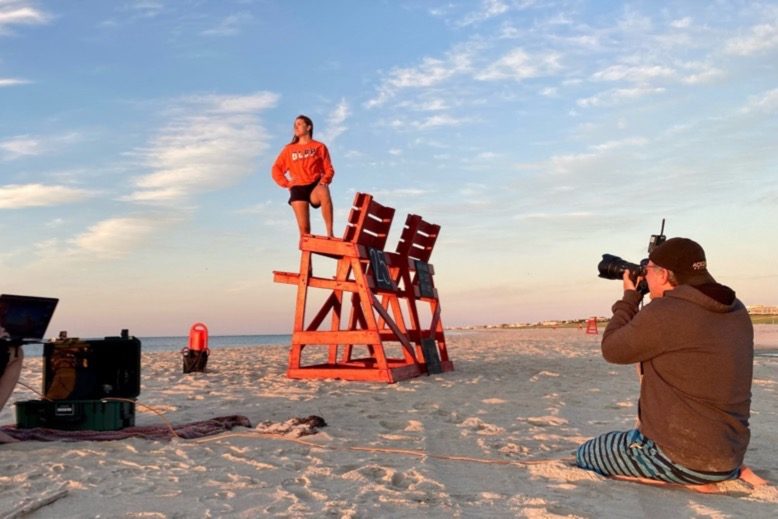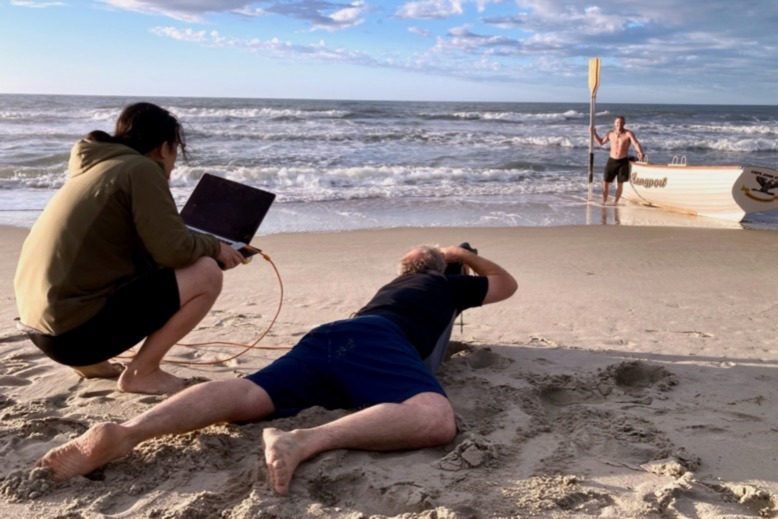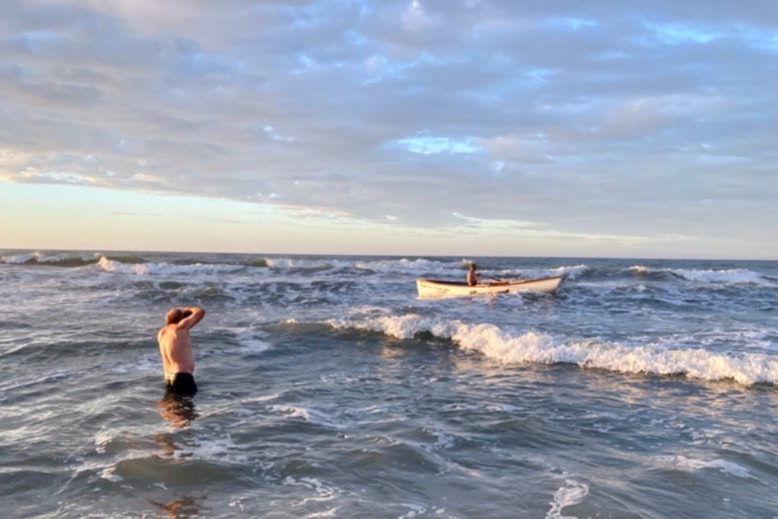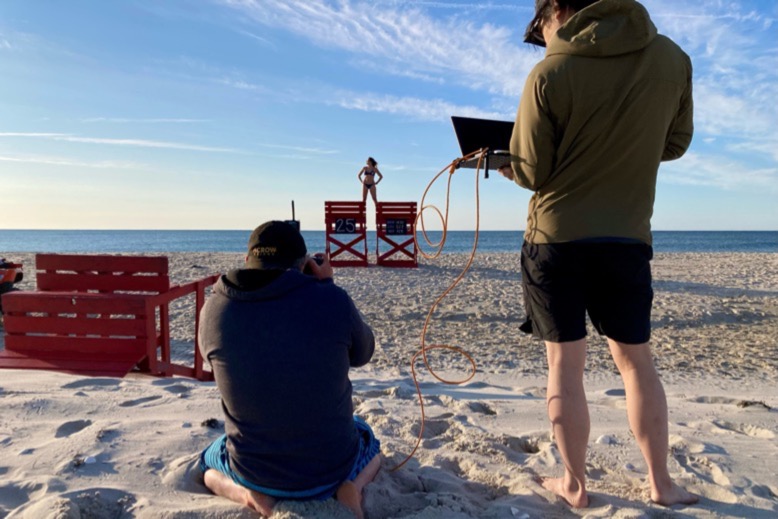
“I’m not a mystic,” Dave Moser tells us—but after a conversation with him, one remains unconvinced. The Philadelphia-based portrait photographer, 54, has traveled the globe to snap pictures of politicians, celebrities and everyone in between. He’s after striking images, of course, but is primarily motivated by the opportunity to forge intimate, at times spiritual connections with his subjects.
In June, our art director, Gail Ghezzi, enlisted Moser to photograph five Jersey Shore lifeguards for a feature in the August issue of New Jersey Monthly. “He has a talent,” Ghezzi says, “for lighting his subjects that give them a monumental, statuesque appearance of power and beauty, no matter what their age or profession.”
Read about Moser’s soulful process—and see behind-the-scenes shots from his NJM photoshoot—below, then check out his final shots.
You describe yourself as many things—an artist, a father, a husband, a cook, an outdoorsman. The one that especially caught my attention was a voyeur. What does that mean to you, and what do you think came first—being a photographer or being voyeuristic?
It’s more about photography being an access to people’s lives. So, photography gets me to the top of a high-rise in New York City. Photography gets me in to meet a president. It’s access to places. If you think about it, too: If someone’s crawling around on the street in rush-hour traffic, they’re nuts. But if you put a camera in their hand, they’re just a photographer, you know? You can go places and do things with a camera.
I have hung out of planes with a harness, and I don’t think I could do that without a camera. I’ve rappelled high rises. I’ve photographed surgery; I’ve had my hands inside bodies. But you take away the camera? I would not be okay. But the camera kind of creates a little bit of a removal, an abstraction. It allows me to do these things. I’ve walked around on 40-story buildings—the girders—while they’re building them. But I’m fine, because I’m taking pictures. I’m focused on that.
But when my wife was in for an ultrasound, there was a little blinking peanut on the black-and-white screen, and I almost fainted. Because it’s also personal—that’s what the nurse told me. But, I mean, two months earlier I had photographed a bilateral lung transplant where the entire chest cavity is empty.
The camera almost takes away some intimidation factor?
Well, I’m focused on something. It’s like how surgeons don’t have to go to the bathroom when they’re in surgery, you know? Everything kind of falls away, and I’m focused on what I’m doing, and I’m happy.

Everything else “kind of falls away” during a shoot, Moser says. Photo by Scott Featherman
You’ve talked in interviews about going right into personal conversations with the people you photograph, and how they often let their guard down as a result. You seem like a very friendly, empathetic, curious person to begin with—it makes me wonder if people would maybe share things about themselves with you even if you weren’t taking their picture. But is there anything specific or heightened about the camera itself that you think gets people to open up to you?
No, I think the camera does quite the opposite. When you put a camera in front of someone, they close down. I’m often trying to—I hate the expression, but—find who they are; discover things about them as I’m shooting. But there’s no pretense: I’m there to take pictures. So before I start photographing someone, I spend a considerable amount of time just talking to them—explaining what I’m gonna do and that they really don’t have to do what I ask or answer my questions, but that we’re on the same team. I enroll them, and then we just go.
I ask a lot of questions. I’m silly. I’ll dance. I’ll ask them to jump. No one looks the same after they’ve jumped in the air. When you land, you’re not the same person. It’s kind of a profound thing. A lot of this stuff is beyond words, which is what I also enjoy.
People become more attractive to me as I photograph them because I’m getting to know them. It’s an intimate process; it’s a human connection. For some people, it’s their job to have their guard up, but that’s rare—most people want to play along. When a shoot’s over, I’m kind of sad, because I’m never gonna see ’em again. I’m losing a friend.
I feel like I can see what people looked like as kids when I’m photographing them at certain times. It’s when everything drops away, and you’re just looking at someone. It’s like when you’re with a kid, and there’s no cynicism—there’s nothing there; there’s just them. And it’s really moving.

Moser and his subjects are “on the same team,” he explains. Photo by Scott Featherman
That’s lovely. Do you ever improvise while photographing someone based on something they say or do or reveal to you?
More often than not, yeah. Most of the time I want them to look natural and relaxed and comfortable in their own skin—all of that is power, you know?—and so I will look for expressions or gestures or ways of standing that are comfortable to them. Or sometimes I’ll go against that and make it uncomfortable to see where they return to. Sometimes making them uncomfortable creates a whole other scenario of reactions and interplay.
I would say I improvise in terms of the way I work with people. There are questions I ask more often than others to get going, but then I’m listening very carefully to what they’re saying and trying to further the conversation. And it depends on the shoot—sometimes it’s gotta happen fast and I’ve gotta ask a lot of questions and try to get them to laugh. And other times I’ve got more time, and it’s a slower process, and I can really kind of settle in for a conversation.
And then in terms of lighting—sometimes the lighting is about the brand; it’s about the style. But other times I’m lighting to highlight something on someone, or create drama, or create something that’s pleasing. So I’m looking at their features and then changing the light to complement them. Sometimes I’ll use really hard light, sometimes super soft light, sometimes the lights from above.
If this job was predictable, and the same thing every day, I couldn’t do it.

Subjects looking comfortable in their own skin, Moser says, is a form of power. Photo by Scott Featherman
Of your portrait subjects, you’ve said that it’s “paramount” to you to “portray a sense of understanding and dignity, and convey that to the audience.” Do you have a concrete sense of what made you value that practice?
In college I did a lot of street portraits, and I almost always asked subjects’ permission. The only times I wouldn’t ask permission is if I felt like it would change the situation so much that it wouldn’t be a picture anymore. But often I would still go up and talk to the people afterwards. And this isn’t a judgment against other forms of photography, or how other people photograph—this is about how I choose to do it—but I don’t want there to be any pretense. I’m not a photojournalist; I see myself as a portrait photographer, a commercial or fine art portrait photographer—editorial, whatever. So I want people to know I’m photographing them. I want the directness. They don’t have to maintain eye contact, but it’s the interaction; it’s the connection that’s so important to me.
Probably 10 years ago, it came to my attention that if I didn’t photograph people, I’d do something else for a living. It doesn’t mean I don’t love photography, that I don’t love taking pictures and lighting and travel—all those things I love—but people are at the heart of it for me. It’s that intimate connection with them.
I’m inside someone’s life for a period of time, and then I’m gone. And I feel like everyone deserves respect and dignity. Everyone is worth understanding.
This interview has been edited for brevity and clarity.
